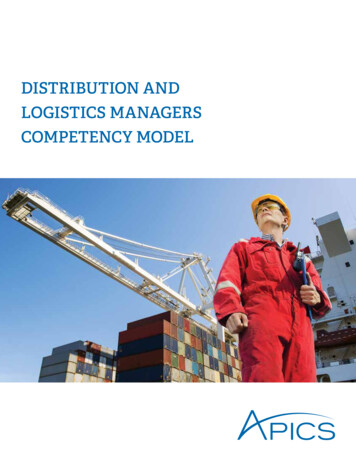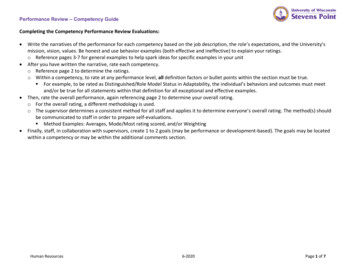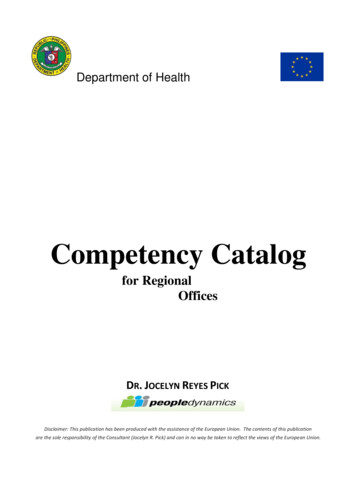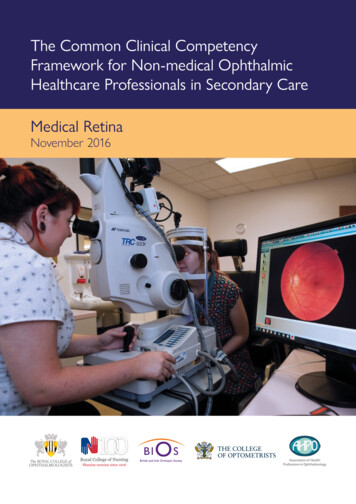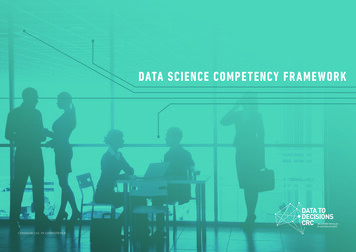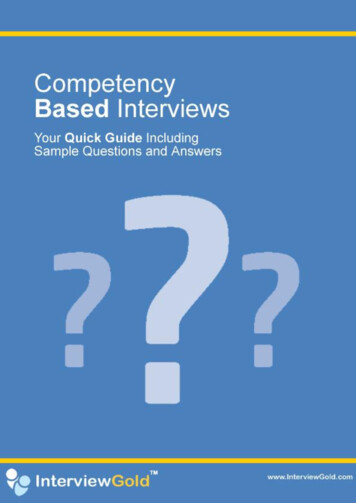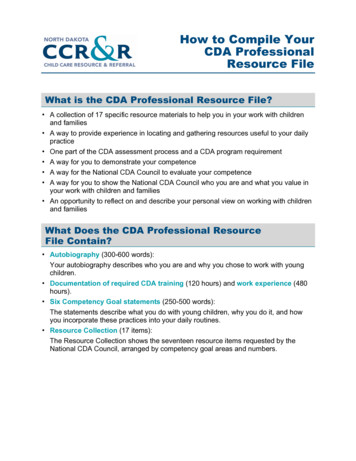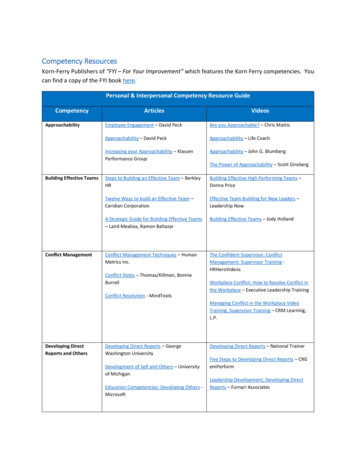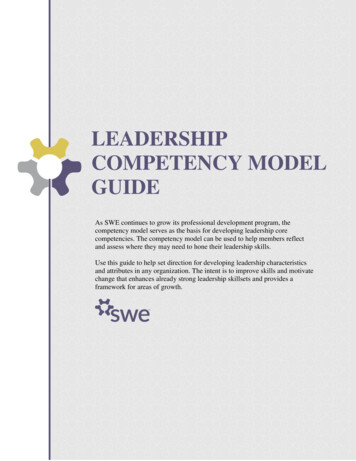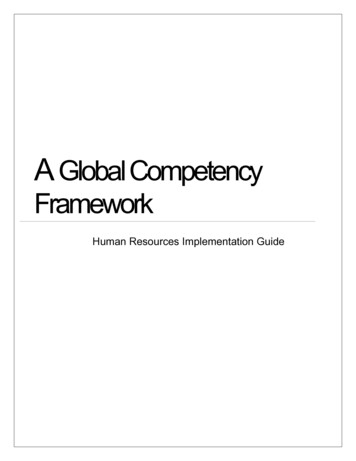
Transcription
A Global CompetencyFrameworkHuman Resources Implementation Guide
Table of ContentsGeneral Overview . 3Supporting Material . 4Background . 5What is Meant By a Competency? . 6Why Develop Competency Models? . 8General Guidelines . 9The Global Competency Framework . 10Designing Competency Profiles - Use of Job Roles . 14Job Role Classification Guide . 15Job Role Type Questionnaire . 17Competencies Included in the Job Roles . 19Determining Proficiency Levels for Individual Competencies . 21Process Validation . 29OCM - Organizational Change Management . 29Process Flow Chart . 31Competency Profile Template . 32Glossary of Terms . 33Questions & Answers . 352 2017, Workitect, Inc.
GENERAL OVERVIEWThis guide has been developed to help Human Resources generalists and specialists,throughout our world to understand and use the Global Competency Framework.As the Competency Framework is implemented throughout our global business, it will create acommon language to describe what superior performance looks and feels like. This will enableall employees, but especially those in leadership positions, to gain greater understanding of therequirements of their jobs, identify and maximize their strengths, and enhance their performanceagainst their development needs. It also provides a link between behavioral expectations ofsuccess and our corporate strategy. The reason is that appropriate behavior leads tosuccessful performance, which in turns helps the business reach the overall strategic objectives.The Competency Framework is a key resource to align HR systems and programs to our overallcorporate strategy. It provides a structure and consistency of approach which will allow theHuman Resource function to better support leaders, and ultimately all employees, by improvingthe way we link behavior and superior performance, help create clearer development modelsand contributing to way individuals integrate into our culture.The Framework has been designed to reinforce key messages about: Corporate Values and Culture Personal Leadership Strategy and DirectionIt is essential that all HR employees are familiar with the design and use of the GlobalCompetency Framework, in order that they can be effective in providing support for theirrespective business partners. This is especially true since the implementation of Competencieswill mean that jobs requirements will be more specific and transparent. The changes in the wayjobs expectations are perceived will impact the way employees are held accountable for thebehaviors they exhibit, the way we focus our Training & Development efforts, drive ourRecruitment and on boarding efforts, etc.This guide presents the key features of the Global Competency Framework. It also providespractical guidance for applying the competencies to groups of as well as individual jobs.It is suggested that all facilitators use our corporate OCM (Organizational Change Management)tools and resources to support the introduction of new processes, systems or programs. Amethodical, planned approach can greatly enhance our expected adoption results and also helpmitigate any risks we may encounter. Please contact your Regional HR Generalist for moreadvice and examples on OCM.3 2017, Workitect, Inc.
SUPPORTING MATERIALThis guide is primarily for HR partners and business leaders if appropriate. We have designedadditional resources to help with local implementation. Among these resources we can find: Global Competency Framework Presentation – A power point presentation for you touse during informational sessions with your customers. The Global Competency Framework Dictionary – This is the dictionary that containsall our competencies and provides the list of associated behaviors. Thisresource is valuable to use to improve our understanding of what behaviors are partsof each competency, and how to determine the different proficiency levels for eachone. Competency Toolkit – These are templates and other materials that you may use asyou are rolling out the framework. They include the Competency Profile templateand the Role Type Questionnaire.Please direct any question about this guide, its application or policies about its use to yourappropriate Region HR Generalist.4 2017, Workitect, Inc.
BACKGROUNDA corporate sponsored project team was charged with developing a Global CompetencyFramework. This was done in response to increased employee feedback received in anEmployee Engagement Survey about the need to create a common language that describessuccessful performance across the company. From the HR perspective, it is also important tocreate a single approach that could accommodate the similarities and differences in terms ofexpected behaviors in jobs.The main expectation is to create a framework that is: Flexible: markets and business units can implement with few edits; adaptable tomeet future changes User friendly: easy to understand Simple: easy to useHaving a Competency Framework enables the HR function to better support the business byproviding the following benefits: A way to communicate and reinforce our core values and visualize the increasingimportance of new strategies and ideas Consistency in the use of competencies; avoidance of duplication and simplicity ofapproach Alignment of HR policies and processes around a common language Measures of individual and organizational capability Role ClarityA validation exercise was undertaken to test out the concepts and applications of the newGlobal Competency Framework. In other words, we wanted to insure that the behaviors thatwere identified would, in fact, be effectively linked to job success. This process (using statisticaltesting and focus group feedback) clearly demonstrated the positive relationship betweenbehaviors and superior performance.5 2017, Workitect, Inc.
What is meant by a Competency?Competencies are typically thought of having an “underlying” characteristic. This means thatwhile we can see the resulting behaviors, the behavioral “drivers” or motivators for thesebehaviors are usually not easily apparent. The iceberg model helps us understand what wemean by an “underlying” characteristic.Iceberg Model of tivesBehaviors providing evidences of a competency are observable above the surface. Therationale for using competencies to predict performance is that while you can’t know andmeasure what is happening below the surface, the observable behaviors are a good indicationof how individuals will perform.But the essence of the competency is underlying and not directly visible. A competency may bea skill, such as Influence through Communication. Competencies may primarily involveknowledge. An example is organizational awareness, which may be defined as knowledge ofan organization’s structure, procedures and policies, as well as knowledge of its norms andvalues. Some competencies are defined as values, for example, Live the Way, which isall about the unique culture prevalent in the company.Other competencies are essentially traits, such as Adaptability. Traits are enduring aspects ofpersonality. As a side note, it is usually easier to recruit people that already have the requiredtraits, than to try to develop the traits in people who do not possess them.6 2017, Workitect, Inc.
At the deepest level of personality are motives.These motives are often reflected in competencies, such as: Self-Motivated -- based onAchievement Motivation; Teamwork – based on Affiliation Motivation; and Influence throughCommunication – based on Power Motivation.At we have a working definition. For our purposes, competencies can be bestdescribed as:“Specific behaviors that are linked to superior individual and organizationalperformance”To summarize, we can see that Competencies can be said to comprise essentially of three mainelements.a) The easiest to obtain KNOWLEDGEb) The element which can be acquired and practiced SKILLSc) The element which puts these together ATTITUDE (which includes values, traits andmotives)Let’s use the analogy of how we go about driving a car.We all begin with some acquired knowledge (using the Highway Code, or Traffic Rule Book)Then, we develop and refine our skills (for example hand/eye coordination)We all pass the same Test and yet drive differently. What differentiates drivers? It is usuallythe attitude.7 2017, Workitect, Inc.
Why Develop Competency Models?Business ReasonsThe business reasons involve getting better business results from people in a job, by:1. Selecting and promoting people based on specific characteristics that are better suited forsuperior performance in the job.2. Providing employees with constructive feedback on how to improve behaviors that lead tosuperior performance in the job.3. Training and coaching job holders so that they improve on competencies that allow them tobecome more effective and more productive.4. Rewarding evidences of competencies that contribute to superior performance.Human Resources ReasonsHR leaders, who are responsible for developing the organization’s human capital, usecompetency models to:1. Provide a conceptual basis for HR applications such as selection, professional development,training, performance management and appraisal, and succession planning.2. Reinforce personal characteristics and values that are part of an organizational culture thatwill support the vision, direction and strategy of top managementReasons/Rationale:As a company, we would like a competency framework to contain the following aspects:1. Flexible: local markets can implement with few edits; adaptable to meet future changes2. User Friendly: easy to understand3. Simple: easy to use4. Create common language around HR programs and systemsBenefits to our employees:1. Employees can improve their own personal competencies to create opportunities for careerdevelopment.2. Having clear examples of success can be replicated easier making the performanceassessment process more objective and transparent.8 2017, Workitect, Inc.
GENERAL GUIDELINESThese general guidelines describe the roles and responsibilities of those who are involved increating and maintaining the Global Competency Framework and designing CompetencyProfiles.1. The HR Strategy team will have responsibility for ensuring the ongoing integrity of theGlobal Competency Framework. Any modification introduced to the Competency Dictionaryor to the process for creating Competency Profiles will require approval by the HR StrategyTeam. The HR Strategy team is made up of , Chief People Officer; ,Vice-President of International HR; , Vice-President of Human Resources; and, Director of Employee Organizational Development. Usually, each strategicinitiative also has a project lead. In the case of the Global Competency Framework, thisperson is .2. The Competency Profiles must reflect the actual business requirements of the position, asdescribed in the current job description, rather than the particular strengths or preferences ofindividual employees who are currently in the job.3. No rewriting, rephrasing or exclusion of behaviors may be included in a competency profilewithout first consulting with the HR Strategy team.4. A note about the use of translations. We understand the need to make all this materialavailable in the local language of employees as this will help with understanding and clarity.We do request that care is taken to maintain the conceptual consistency of eachCompetency definition, as well as the associated behaviors. Please involve the HR RegionGeneralist in the translations, whenever possible.5. The HR Generalist supporting each customer area or country has the responsibility toinitiate or modify any competency profile, as jobs are added to the current structure. Thecompetency profile should also be reviewed by the appropriate HR Region Generalist.6. The appropriate business head or country leader should validate any new or modifiedcompetency profile before it is implemented into the job structure. Depending on the natureof the job role, the emphasis placed on stakeholders may vary. Where there is significantdifference in perception, this will need to be discussed before any decision is finalized. Thebehaviors which are contained in the Competency Dictionary were validated to ensure thatthey correlate to superior performance.7. The identification of the primary job role is key to the success of the framework. Wherethere is any doubt as to the Job Role, please contact with the appropriate HR StrategyTeam representative.9 2017, Workitect, Inc.
GLOBAL COMPETENCY FRAMEWORKThe sixteen competencies in the Competency Dictionary are labeled according to how they arefound across the different jobs.This is a brief explanation of each of the three groups:Core CompetenciesThese are characteristics or competencies that should be present in all jobs, regardless of levelor job role – the resulting behaviors can help demonstrate our unique culture and values. Agood example of a core competency is . We would want every single employee of thiscompany to reflect the values that are valuable to this company.Job Role Specific CompetenciesThese are other competencies that vary from job role to job role. This means that they are akey success factor for some jobs, but not necessarily have the same impact for jobs in other jobroles. For example, the competency Attention to Detail will probably be a high success factorfor job roles whose primary focus is to process information or data (Transactional Job Role).This same competency might not have the same priority for a Strategic job role, which is usuallymore focused on viewing the big picture of things.(To see more on Job Roles, please go to page 14)Leadership CompetenciesWe also have included some competencies that are common to all jobs that are responsible forsupervising outputs from individuals or groups. These are competencies we would expect anyleader to show examples of, regardless of level or market size.10 2017, Workitect, Inc.
The Global Competency Framework11 2017, Workitect, Inc.
Example of a Competency:Below is an example of a competency from the Global Competency Framework.Live the Way:Model and promote the culture, brand and core values (Golden Rule, Make Me FeelImportant, Balanced Priorities, Go Give); actively demonstrate these behaviors in every situationand with all audiences.Basic Demonstrates a positiveattitude about the company,the culture and thecustomer; wants to be partof the companyIs helpful to others versusjudgmentalIdentifies with andunderstands how the culturecreates a better workingenvironmentUnderstands and usuallydemonstrates the corevaluesBelieves in the company’smissionSeeks to understand theneeds and requirements ofcustomersComplies with basic servicestandardsIntermediate Displays a genuineenthusiasm about thebusiness, the company, andthe customerDemonstrates a willingnessto serve and contribute inany way possibleApplies the culture andvalues to make decisions,handle business andcustomer issues and toengage othersEncourages others to betterpractice the core valuesFocuses on building solidrelationships with customersthrough meeting orexceeding their needsFrequently exceeds basicservice standardsAdvanced Demonstrates anunshakable passion for thebusiness, the customer andthe missionCan energize others aboutthe companyIs a true role model for thecompany and its values;creates an environment thatfosters the culture , thevalues, and the highestlevels of customer serviceDevelops performance andservice standards for selfand others that promote theculture and core valuesDrives self/organization tocreate strong, mutuallybeneficial relationships withtheir customers by providingexemplary serviceIt begins with the name of the competency and then the definition identifies the underlyingabilities or traits or the outcomes of the competency.In addition, there are three defined levels of behavioral indicators that describe the behaviorsthat someone would exhibit in demonstrating the competency at increasing levels of capability,in other words, “what the competency looks like in terms of behavior.”A five level proficiency level progression is provided to allow for dealing with complexity, whichfalls between the defined levels. More explanation on the proficiency levels is given further intothe guide.On the next page, an actual Competency Dictionary page is shown to explain how all this fitstogether.12 2017, Workitect, Inc.
A Competency Dictionary PageThis is how an actual Competency Dictionary page looks. It contains all the information neededto understand how it links to specific jobs and expected behaviors.13 2017, Workitect, Inc.
DESIGNING COMPETENCY PROFILESThe Use of Job RolesOne of the first tasks at hand is to link Competencies to actual Job Descriptions, so that itbecomes clear what behaviors are key to successful job performance for every existing position.To facilitate the process of creating Competency Profiles for all our jobs in , we haveintroduced the use of Job Roles, and predetermined the competencies that will accompanyeach job role. Job roles describe the way in which each person adds value to the business andbest carries out the mission, along with the nature of that particular contribution. The job rolesgroup together jobs, which tend to focus on the same general aspects. The employees thatcarry out these jobs tend to have similar desirable characteristics or competencies. The jobroles are not function specific, that is, job roles may or may not always be in the same job family(for example: finance, sales or operations).All positions in the organization can be described using five basic “job roles”.The five job roles are: cEach employee within the company performs in one or more of these job roles (a definition ofeach is described on page 23). It is not typical; however, that any single job role will operate inmore than two job roles. The use for the job roles is important for two main reasons. It helps to explain the way in which each job is focused on adding value – what the majorcontribution to the company is. This enhances clarity, and can assist in prioritizingobjectives and efforts. The job roles are a key to understanding the different ways in which each competency canbe demonstrated, and the way in which the framework is used.Each job needs to be placed into ONE of the five job roles. We recognize that a lot of jobs willprobably perform in two job roles, but a decision should be reached as to which job role isprimary and key for the job to be successful.It is important to remember that we should use an updated version of the job description toguide our decision on which job role to assign a particular job to. The job holder may becarrying out responsibilities that are outside the scope of their job. Similarly, we may seeopportunities for development in employees that are not fulfilling the extent of their jobresponsibilities. Due to these extraneous circumstances, we should only be guided by what isincluded in the formal job description document.14 2017, Workitect, Inc.
JOB ROLE CLASSIFICATION GUIDEIt is important to note that we will probably find some jobs that are very obvious about what theirrole is, while some others will have aspects of two roles. For the purpose of designingCompetency Profiles, it is important once more to note that every job is categorized into onlyONE job role.It will help understand what these job roles are and how they are defined. Here are somedefinitions to help guide our understanding of how the jobs roles are different one from another.Definitions and Examples of Job Roles and Jobs:Transactional Job RoleThis job role is process driven and operational in nature and administers and operates essentialprocesses, planning and allocating resources to ensure delivery of quality or volume output.There may be daily or routine contact with external or internal customers.Some examples of Transactional jobs are: Distribution Picker, Manufacturing Assembler, andCustomer Service RepresentativeSupport Job RoleThe service support job role adds value by their commitment to provide administrative andlogistical support for the needs of other specific job roles or small groups. They may exercisecertain autonomy to make decisions about satisfying customers’ requirements with definedprocedures. The majority of time is spent in customer satisfying activities and logistical support.Some examples of Support jobs are: Administrative Assistant and Executive Assistant.Relationship Job RoleThese job roles have the responsibility for creating and maintaining optimal workingrelationships with business partners. The customers may be internal or external, for example, ajob which predominantly requires the job holder to influence and gain commitment to proposalswith the Independent Sales force would fall into this job role type.Some examples of Relationship jobs are: Sales Development Associate and HR Generalist.15 2017, Workitect, Inc.
Specialist Job RoleThis job role provides expert advice and guidance to the business in a particular discipline. Theexpert job role should not be confused with the requirement for a set of job specific skills andknowledge to perform a current job role. A key criterion for this type of job role is that theperson adds value to the business by virtue of their training, experience and expertise.Some examples of Specialist jobs are: Attorney, Scientist and IST Programmer.Strategy Job RoleThis job role focuses on analysing and deciding upon the strategic direction and policy of thebusiness, business unit or function. A position focused on looking at medium to long termresults, and making recommendations on the appropriate courses of action, for example, wouldhave a primary strategic element to his/her role.Some examples of Strategic jobs are: Country Head and Function Head.16 2017, Workitect, Inc.
JOB ROLE TYPE QUESTIONNAIRETo help classify the appropriate Job Role for a specific job you may want to use this simpleguide. Following a few simple steps will help identify the particular job role that each job isplaced into. As a note, this process of identifying the appropriate job role for each job is initiatedby HR and not by any job holder, and validated by the appropriate business partner. This simple questionnaire will help you identify your primary job role typeFor each question, circle the statement which most closely applies to your workOnly circle one statement for each questionThere are no right or wrong answers, but it all should be consistent with current jobdescriptionQ1. The employee spends most of their time:a) Processing information, product or data.b) Preparing schedules, complying with administrative procedures and processingcustomer requestsc) Communicating with partners of a particular business processd) Using my specialised expertise to advise the businesse) Preparing strategiesQ2. The employee is mainly responsible for:a) Meeting targets (in volume & quality) and accurate information processingb) Minimizing administrative and logistic burden on position(s) I supportc) Degree of results achieved as a result of strong partnering relationship with mycustomers.d) The quality of my expert advicee) Analysing and interpreting data to support coherent recommendationsQ3. An essential part of the employees’ job is:a) Focusing on the task at hand and using appropriate processes and proceduresb) Quick and efficient resolution of pending tasks and individual requests.c) Continued contact with all customers to adequately gauge and interpret theirconcernsd) Identifying operational opportunities by ensuring specialist techniques are maintainedand developed to support each particular businesse) Predicting significant trends well into the future based on a through assessment ofinformationQ4. The employee’s main expertise is:a)b)c)d)e)Knowledge and skill at maintaining business operationsCan-do attitude and efficient personal organization of tasksSkill at building mutual working relationshipsIn their specialist disciplineStrategic analysis17 2017, Workitect, Inc.
Q5. The employee deals mainly with:a)b)c)d)e)Processes and proceduresSupporting their customersBusiness partnersFellow specialists, internal and/or externalExternal information providers and internal strategistsQ6. To be able to do my job, the employee needs:a)b)c)d)e)Clear operational processes and details on how the process worksClear instructions and expected resultsUnderstanding of expected results, relevant informationSpecialist expertiseUnderstanding of the relevant business environmentQ7. The employee regularly:a)b)c)d)Spend significant time dealing with processesReport on progress to ensure objectives are metSpend time with their customers to understand their needs/expectationsEnsure management are fully aware of technical issues and explain in appropriatelanguage those which may impact on planse) Identify new customer bases, new markets and new products based on marketresearch and customer feedbackQ8. To carry out my role the employee needs to influence:a)b)c)d)e)How well the internal processes workDesired outcomes and problem resolutionMutually agreed goals and resultsThe thinking of the business in their specialist areaMary Kay strategiesNow simply add up how many times you have circled a), b) and so on. The primary job role isthe one represented by the greatest number of circles.Mostly (a): Transactional Job RoleMostly (b): Support Job RoleMostly (c): Relationship Job RoleMostly (d): Specialist Job RoleMostly (e): Strategic Job Role18 2017, Workitect, Inc.
COMPETENCIES INCLUDED IN THE JOB ROLESAll of the 5 job roles have been populated with a group of competencies that best account forthe behaviors that are typically found in that specific job role. The five job roles incorporate theCore Competencies and the Role Specific Competencies from the Global CompetencyFramework. The number of competencies may vary from job role to job role.These are the Competencies that are included in each of the 5 Job Roles:The way the Core and Job Specific competencies are included in each of the five job roles canbe seen below.Job nshipSpecialistStrategicLive the Way!!!!!Learn and Develop!!!!!Adaptability!!!!!Attention to Detail!!Teamwork!!!!Influence Through Communication!!!Build Credibility!!!Navigate Through Ambiguity!Use Information Effectively!Self-MotivatedJobSpecificThink InnovativelyCreate a Vision!!!!!!Once jobs are “sorted” into the appropriate job role, they incorporate all the competencies fromthat job role.If for example, after using the job role type questionnaire, we were to determine that a Managerof Sales Development job best fits into the Relationship Role, the competencies included in theCompetency Profile for that job role would be:19 2017, Workitect, Inc.
Competency Profile (example)Job:Manager of Sales DevelopmentJob Role:Relationship RoleCore Competencies:Live the WayLearn and DevelopAdaptabilityRole Specific Competencies:Influence through CommunicationBuild CredibilityNavigate through AmbiguitySelf-MotivatedUse Information Effectively20 2017, Workitect, Inc.
DETERMINING PROFICIENCY LEVELS FOR INDIVIDUALCOMPETENCIESOnce the appropriate job role has been determined for a particular job, the next step is to assignproficiency levels for each one of the competencies in the job role.This is probably the most complex aspect of building individual competency profiles for jobs.The objective is to use the behavioral aspects of a particular competency to assign a“proficiency level category” for that particular competency by a 1 – 5 scale.There are a few guides and points to keep in mind as we do this: The behaviors for each competency are found in the Competency Dictionary. The proficiency levels are indicative of a growing complexity in the behaviors that evidencea particular competency. The Basic – Intermediate – Advanced labels should not beassociated with individual performance levels. The proficiency levels should be
1. The HR Strategy team will have responsibility for ensuring the ongoing integrity of the Global Competency Framework. Any modification introduced to the Competency Dictionary or to the process for creating Competency Profiles will require approval by the HR Strategy Team. The HR Strate
